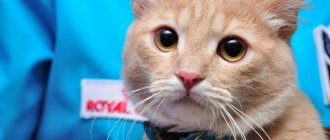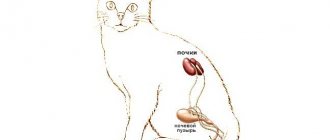The sexual behavior of cats often becomes a problem for their owners. The nature of pets requires that they look for partners for mating, guard and mark their territory, and show aggression towards potential rivals.
Sterilization or castration can solve the problem of sexual behavior once and for all. Despite the fact that the operation itself is quite simple to perform, cat owners should prepare for the procedure in advance and learn how to prepare a cat for castration.
Briefly about castration
Castration involves complete or partial removal of the gland and reproductive organ (testes in both sexes and uterus in cats). Such an operation solves two problems at once: the animal’s behavior is corrected and the possibility of having offspring is suppressed.
Direct indications for castration are:
- oncology of organs and tissues of the reproductive system;
- genital injuries;
- urolithiasis disease;
- genetic pathologies.
Most people confuse or do not share the concepts of sterilization and castration of animals, mistakenly believing that only cats are castrated, and only cats are sterilized, although both operations are applicable to pets, regardless of their gender.
Sterilization, in turn, involves ligation of the fallopian tubes in cats or the seminal canal in cats. Sexual function in pets is not suppressed. Thus, the animal retains the urge to mate, continues unwanted sexual behavior, but is unable to produce offspring.
The procedure should be chosen based on the characteristics of the animal and the recommendations of the veterinarian. The owner should remember that preparation for the operation, carried out properly, reduces the risks of negative consequences of surgical intervention.
Consequences
The consequences of the operation include complications after emasculation, predisposition to diseases, as well as changes in behavior.
During the operation, bleeding may occur, which is eliminated by the surgeon. Primary hemorrhage is less dangerous than secondary hemorrhage, which occurs suddenly, after a few hours, and can cause death from large-scale blood loss. Therefore, the animal owner needs to maintain contact with the operating veterinarian.
Most often, the problem arises when castrating an elderly patient using the open method. But even in young cats, due to a congenital anomaly, the inguinal rings may be too wide, the vaginal membrane, the stump of the vas deferens, intestinal loops or omentum fall out. The pathology is corrected surgically.
Wound infection
The infection is caused by a cat scratching or licking the wound surface. For protection, a blanket is put on the body of the operated animal. To prevent the cat from licking itself, an Elizabethan collar is used. The cat litter box is cleaned of feces twice a day.
READ Feeding standards for pigs: what and how much to feed piglets, boars and sows?
For emasculated cats, two metabolic pathologies are characteristic - urolithiasis (urothiasis), as well as obesity and its consequences.
The disease occurs as a result of drinking poor-quality water, but more often due to poor nutrition. Economy-grade feed, fish, and meat trimmings lead to an excess of nitrogenous components. They are toxic, and the cat’s body eliminates them in the form of sparingly soluble uric acid salts. When precipitated, stones are formed, creating obstacles to the outflow of urine. Mostly males suffer due to the tortuosity of the urethral meatus.
After emasculation, the cat's body continues to grow, but the lumen of the urethra, the development of which is influenced by androgens, remains unchanged. This is the main cause of the disease. You can prevent urotiliasis by using soft, preferably bottled, water, as well as food for castrated animals. You cannot treat your pet to fish, meat or human food.
Very fat cat
Obesity
Depriving a male of his manhood leads to hormonal modification, which negatively affects mobility. Obesity causes diseases such as:
- cardiac and renal failure;
- urothiasis;
- constipation;
- diabetes;
- arthritis;
- malignant neoplasms.
You can get rid of excess weight by limiting the amount of food, as well as by arranging active games. The apartment should have toys - “tall tree”,
"Tall tree"
House for a cat, teasers, game tracks, wind-up mice, etc.
House for a cat
Proper preparation for surgery
Any surgical operation requires thorough preparation. Castration of a cat: what you need to know before the operation:
- for sterilization and castration of animals there is an optimal age and there is an age of risk;
- both techniques involve placing the animal under general anesthesia;
- any problems with the pet’s health can affect the course of the operation and the postoperative period;
- Compliance with the veterinarian's requirements for preoperative preparation is vital.
During the preliminary consultation, the veterinarian explains in detail to the owners the rules for preparing the animal for surgery, the possible risks of complications and consequences.
Rules for feeding an animal before castration
Castration is an operation using narcotic substances. Their side effects are often manifested by the urge to vomit during narcotic sleep and in the postoperative period. Therefore, it is advisable to prescribe the animal a 12-hour fasting diet before castration. This means that 10 - 12 hours before surgery, the pet is completely cut off from access to food. Such fasting is easily tolerated by animals and does not lead to any diseases. A cat's empty stomach on the eve of surgery will prevent discomfort for both the family pet and the owner.
Sterilization of females is a more complex operation compared to castration of males. During this procedure, similar narcotic drugs are used and it is important that the animal’s stomach is empty.
Sterilization of a cat is a routine operation in veterinary practice, with a minimum of complications in the postoperative period. A competent approach to deciding what needs to be done before sterilizing a cat will allow the owner to calmly carry out this manipulation with the animal without experiencing discomfort or unpleasant situations. Proper preparation of the pet by its owner for the operation is the key to a comfortable stay in the clinic during castration and reducing the risk of postoperative complications.
Optimal age
The optimal age for castration of a cat is considered to be the period of its full maturity. In most breeds, this age occurs at 7-9 months of age. It should be clarified that especially large breeds mature a little slower (by 8-10 months), and small animals need to gain sufficient body weight.
A cat that is fully formed and its organs are functioning at full capacity reaches sexual maturity by one year. From this moment on, his testicles and pituitary gland begin to actively produce hormones that provoke sexual behavior in the pet.
But an adult cat under 7 years of age is not at risk from sterilization or castration surgery if precautions are followed. After the veterinarian’s command “prepare”, we prepare the animal in accordance with all established rules.
To castrate or not
Since cats, when they reach the age of sexual activity, begin to behave unusually, the question arises - the age at which a cat can be castrated. The owners are annoyed by their aggressiveness, the eternal humming of “meow”, as well as the smell of urine throughout the apartment. All this, naturally, does not suit the owners of a furry male, so the question of castration is acute for them (see how long it takes to castrate a cat).
As you can see, such an operation is not a whim, but rather a necessity. Because the animal also suffers from this. Of course, everyone has the right to decide for themselves what to do with their pet. However, it is possible to help him and yourself only by removing the animal’s testicles.
So at what age should a cat be spayed? The most favorable age for castration is six or seven months. Since the animal is already more or less formed, but the sexual desire is not yet so strong. And the cat’s health for up to a year must be excellent, which will help him more easily endure both anesthesia and the operation itself.
Care before surgery
There is a set of established rules and recommendations for the care of animals undergoing surgery:
- absence of direct contraindications for castration of a cat;
- normal appetite;
- normal body temperature;
- no problems with stool;
- a deworming procedure and general treatment against parasites were carried out;
- good tests and vaccinations done on time.
If owners have any doubts about the health of their pet in the preoperative period, they should immediately inform the veterinarian. Adult cats over 5 years old are recommended to undergo general blood and urine tests first.
Bring your cat in a plastic carrier
It is better to bring the patient to surgery in a rigid carrier with a locking door. Cover the carrier with absorbent diapers. Bring a few diapers and wet wipes with you. As a rule, large clinics offer postoperative hospital services and return the animal to its owners after it has completely recovered from anesthesia. In smaller clinics, you may have to sit with the cat while they give him an IV, and then take him home in a state where he has not fully recovered. The plastic carrier is easy to wash in case of embarrassment.
It is better to sit with a completely lethargic cat in the clinic, give him time to wake up under the supervision of doctors.
It’s worth going home when the cat holds his head confidently and at least stands up on his paws.
Take something warm with you to the clinic: an old scarf, sweater or terry towel so that the cat does not freeze after the operation.
Castration of a cat is a continuous, relatively simple operation, so it usually goes without complications.
The following tips are general in nature, but will be especially useful if you neutered your cat at home or in a small clinic.
This is interesting: Time of the first bath after castration
Treatment for worms
Preventive treatment of pets against parasites, both external and internal, should be carried out every 3 months (at least 2 times a year). At the same time, the fight against external blood-sucking parasites, such as fleas, ticks, etc. may be needed more often when the animal spends a lot of time outside or communicates with other representatives of the animal world.
10 days before the day scheduled for surgery, it is recommended to treat the cat for helminths (if more than 1 month has passed since the last treatment). Veterinarians recommend using drugs such as Kanikquantel, Milbemax, etc.
Hygiene is the key to successful castration!
All cat owners need to know that washing the animal is prohibited for at least two weeks from the date of the procedure. It will be necessary to wait until the post-operative wounds have completely healed. So before the procedure (a couple of days before it), it is advisable to wash the cat. This is especially important in the case of long-haired animals, whose thick fur is no worse in efficiency than a regular mop for washing floors.
Moreover, if your cat is extremely shaggy, be sure to trim the hair in the scrotum area and trim his tail at least halfway, starting from the root . Even if the animal ends up looking suspiciously like a poodle, it is guaranteed that no hair will get into its operated scrotum.
Remember that high-quality preparation is the key to a successful operation and a quick recovery of the cat after it!
Vaccination for a cat
An animal that is not vaccinated in a timely manner runs the risk of catching an infectious disease while walking, and during a surgical operation the risk increases several times. At least 1 month must pass since the last vaccination, only then can the cat be castrated without fear of infection.
There are cases when, for one reason or another, animals that were not vaccinated on time are allowed to undergo surgery. In this case, the pet is injected with a serum that protects the cat from infections for 2 weeks. This approach increases the cost of the procedure and shifts responsibility for some postoperative complications to the owner.
Options for castrating a cat at home
| Budget | Standard | Optimal | VIP | |
| Calling a veterinarian to your home | ||||
| Castration | ||||
| Three-component European anesthesia | — | |||
| Recovery from anesthesia | — | — | ||
| IV | — | — | — | |
| Antiviral serum | — | — | — | |
| Promotion until June 30, 2021 | 3200 rub. 2500 rub. | 4800 rub. 3500 rub. | 5800 rub. 4300 RUR | 8800 rub. 7300 rub. |
PS A dropper and the administration of hyperimmune serums completely normalizes the animal’s condition and protects it from infectious diseases within 2 weeks.
Preoperative fasting
Due to the fact that cat castration surgery involves general anesthesia, the owner should deprive the cats of food for the last 12 hours. It should be recalled that for carnivores, which include all cats, fasting for 1-2 days is normal and does not harm their health.
Fasting concerns only food, there is no need to exclude water. The reasons for “forbidden” and why you cannot feed the cat lie in the fact that vomiting may occur during the operation. If the animal's stomach is not empty, it may choke on its own vomit.
General information
There are only two disadvantages to the operation:
- Castration is not reversible.
- If there are errors in diet and due to the characteristics of the breed, the cat may develop urolithiasis over time.
There are many more advantages to castrating a cat:
- The cat stops marking its territory.
- Problematic behavior during the rut becomes a thing of the past, as the rut no longer happens.
- The cat becomes more docile, aggression decreases.
- The risk of prostate cancer is reduced or completely eliminated.
- Castrated cats live 1.5-2 years longer than their uncastrated counterparts.
How to avoid side effects?
Adverse reactions that may occur during and after surgery include:
- stress;
- impaired coordination and orientation;
- loss of control over urination, less often during bowel movements;
- nausea and refusal to eat;
Despite the negative aspects, there are also positive aspects. These include a greater likelihood of resolving the problem with marks, the appearance of which is directly related to the animal’s sexual heat.
A good appetite and moderate thirst are sure signs that the operation went well. A castrated animal begins to actively eat on the second day. To alleviate your pet’s condition, you should not make changes to its usual diet in the first 10 days after castration.
In some cases, dietary nutrition is prescribed by the clinic veterinarian who castrated the animal: how many hours should the cat not be fed before castration, what to feed it after, and other similar questions should be asked to the surgeon.
It is impossible to completely protect your pet from the consequences, however, following the rules of preoperative care and preparation will minimize the risks of complications.
The degree of fatness as a factor influencing the success of the operation
This is also an important factor, which, unfortunately, is not always remembered by breeders and veterinarians themselves. How does a cat’s nutritional status affect the potential success/failure of surgery? It's simple.
If the animal is exhausted, any operation is prohibited, since its body simply cannot withstand the consequences of general anesthesia.
Excessive fatness also does not bode well. Firstly, anesthetic drugs may not have an effect on the “bun”’s body. Simply put, your well-fed pet can suddenly die from pain right on the operating table. The prospect is not good...
In addition, “chubby people” are characterized by another feature. Subcutaneous fat is not only a natural accumulator of energy reserves. Many hormones accumulate in its thickness, including sex hormones... All this leads to the fact that a well-fed cat, even being castrated, can demonstrate behavioral characteristics for months (and in some cases for several years) that are uncharacteristic for castrated cats.
The cat continues to eagerly rush after the cats and fight with his relatives, as if nothing special had happened. The older the pet was at the time of the operation and the more subcutaneous fat it managed to accumulate, the longer this behavior will manifest itself... Do not forget that components of medications administered at the time of surgery can just as well accumulate in adipose tissue. In the future, when the animal loses weight, all this will end up in the general bloodstream. Needless to say, what unexpected consequences this can lead to...
Thus, even at the stage of planning the operation, it is worth thinking about “fitness” for the cat (of course, only in cases where its weight is more than normal).
But! Your pet should also not lose weight too sharply, as this can lead to unpleasant consequences.
In such cases, there is a high probability of developing cardiovascular pathologies. To bring the pet's weight back to normal, about three or four weeks before surgery, he is put on a diet, reducing the overall nutritional value of the diet by 25%. During this time, the excess weight will go away quite smoothly, and the animal’s health will remain normal.
Tests and vaccinations
In order for a cat to be admitted to surgery without any problems, the following medical certificates must be provided:
- the result of a general blood test;
- blood biochemistry results"
- urine test results;
- a certificate from a cardiologist about the state of the cardiovascular system (for “aged” cats and animals suffering from obesity).
Since castration takes place under general anesthesia, anesthesia can provoke an increased load on the heart, therefore, in the presence of any cardiac pathologies, sterilization of males is strictly contraindicated.
The tailed patient, like a person, needs to be tested before surgery
After surgery, keep the animal at rest.
Recovery from anesthesia lasts from 4 to 12 hours. At the same time, the cat staggers, drools, does not always find the tray, and may vomit. This is a normal condition after anesthesia. Don't be alarmed, but control your pet's movements if possible.
- After surgery, it is better to limit the cat's movements. Even if the cat came to his senses and began to move independently, his coordination will be impaired for several hours: he may fall and get injured. After returning from the clinic, it is better to place your pet on a flat surface, on the floor, or leave it in a carrier. Place an absorbent diaper, blanket or towel underneath.
- To make it more comfortable for your cat to wake up, curtain the carrier or window in the room. Eyes after anesthesia are very sensitive to bright light.
- Anesthesia causes the body to cool by about a degree to one and a half degrees, so keep your pet warm.
If the cat remains in the carrier, it can be placed next to the battery. Warm (not hot!) water should be freely available. Do not place your cat ON a radiator, near heaters with an open coil, or on a bottle of boiling water. If it's warm outside or at home, additional heating may not be needed. Watch your cat carefully and act according to the situation.
- When the cat comes out of anesthesia, forcefully “blink” it so that the cornea does not dry out. You can drop saline solution or moisturizing drops into your eyes.
- Make sure your pet breathes freely and does not stick his nose into the carrier or the wall.
- When recovering from anesthesia, the cat may be aggressive. Don't wake him or bother him. Do not allow other animals or household members near him.
- Reduce the layer of filler in the tray or place an absorbent diaper in the tray to prevent dust from getting into the post-operative wound.
- You should not feed your cat in the first hours after surgery. After his coordination returns to normal, usually six to seven hours after the operation, offer him some food. If you are in doubt about whether to feed, wait until the evening or morning, depending on the time of the operation.
Prevention of complications after castration
Prevention of complications in a cat after castration is a whole range of measures that should not be skipped in order to avoid unpleasant consequences. You may be offered to leave your cat at the clinic for a day, but try to refuse this, because the pet needs the love and care of its owner.
During the first five hours after the operation, your cat will be lethargic and very weak. Therefore, it requires careful care. The cat will most likely experience dizziness, thirst, or vomiting. This is a normal phenomenon; animals recover from general anesthesia this way, so the owner should not worry.
Most often, animals endure pain quietly, do not approach food and constantly lie or sleep. The pupils are dilated and constantly look at one point. To relieve your cat's pain, you need to purchase painkillers. Human drugs cannot be used. Before purchasing them, you should definitely consult your veterinarian.
While caring for your cat, you need to provide him with complete peace; try to limit communication with other animals and children. The main thing is that the cat always has clean water and food in sufficient quantity.
Important! For better wound healing, you need to buy brilliant green and 3% hydrogen peroxide. They need to treat the wound twice a day. To treat, moisten a cotton swab with an antiseptic and blot the wound with it. Don't rub! This may damage the seams or tear off the scab.
To prevent your pet from licking the wound, you need to purchase a special collar. It will not allow the animal to reach the groin area. You cannot remove the collar; it will not prevent the cat from moving around the apartment and eating.











